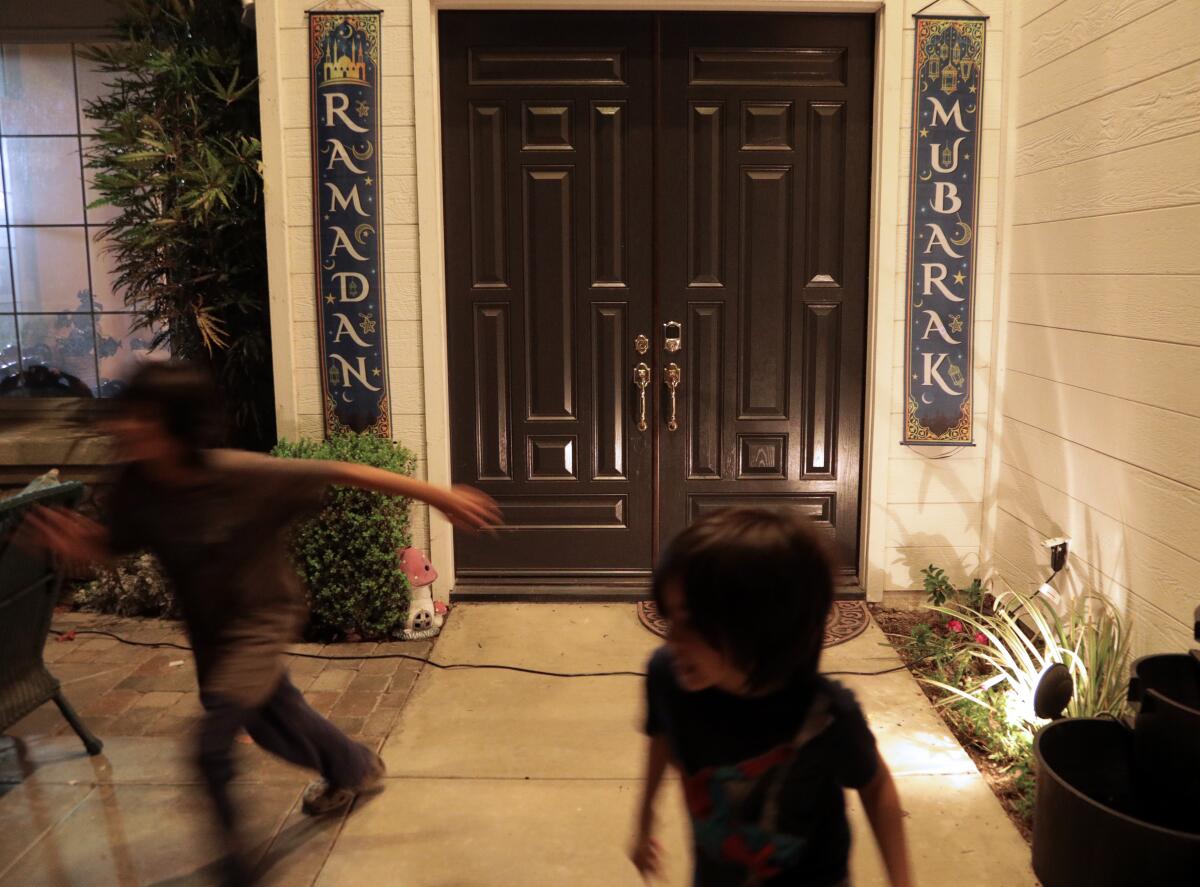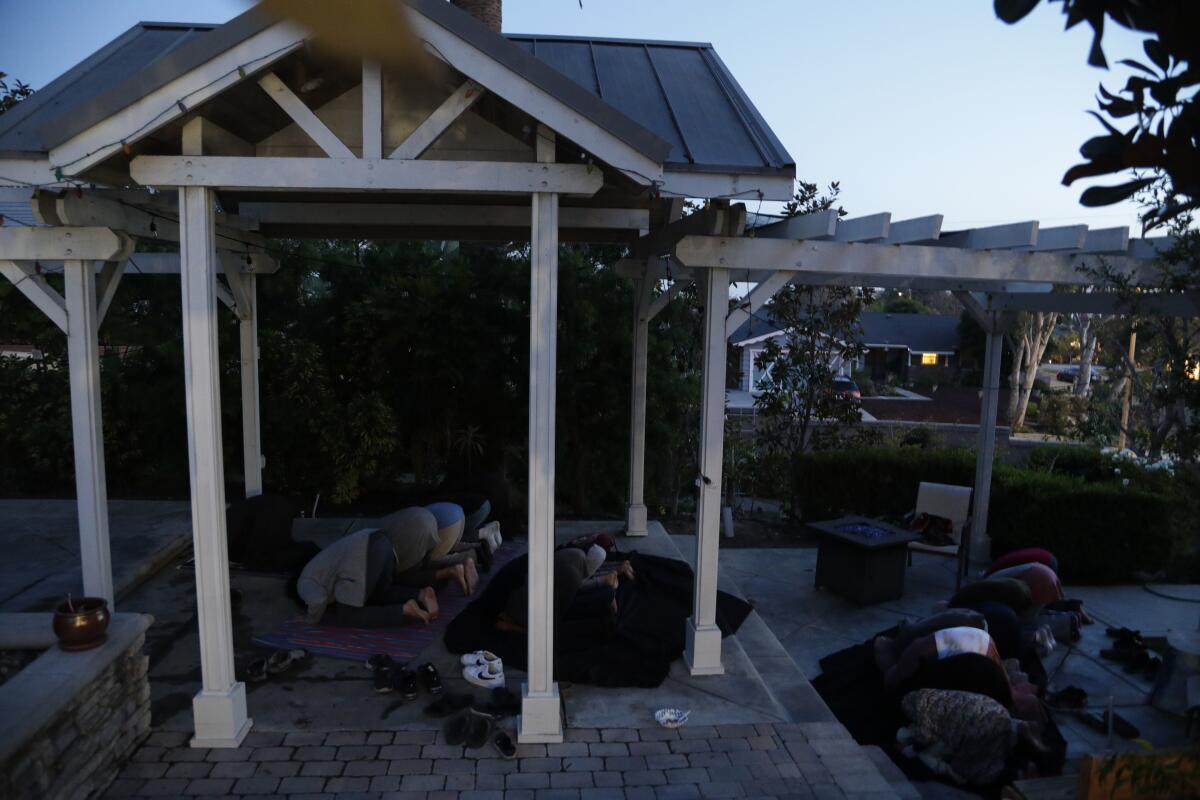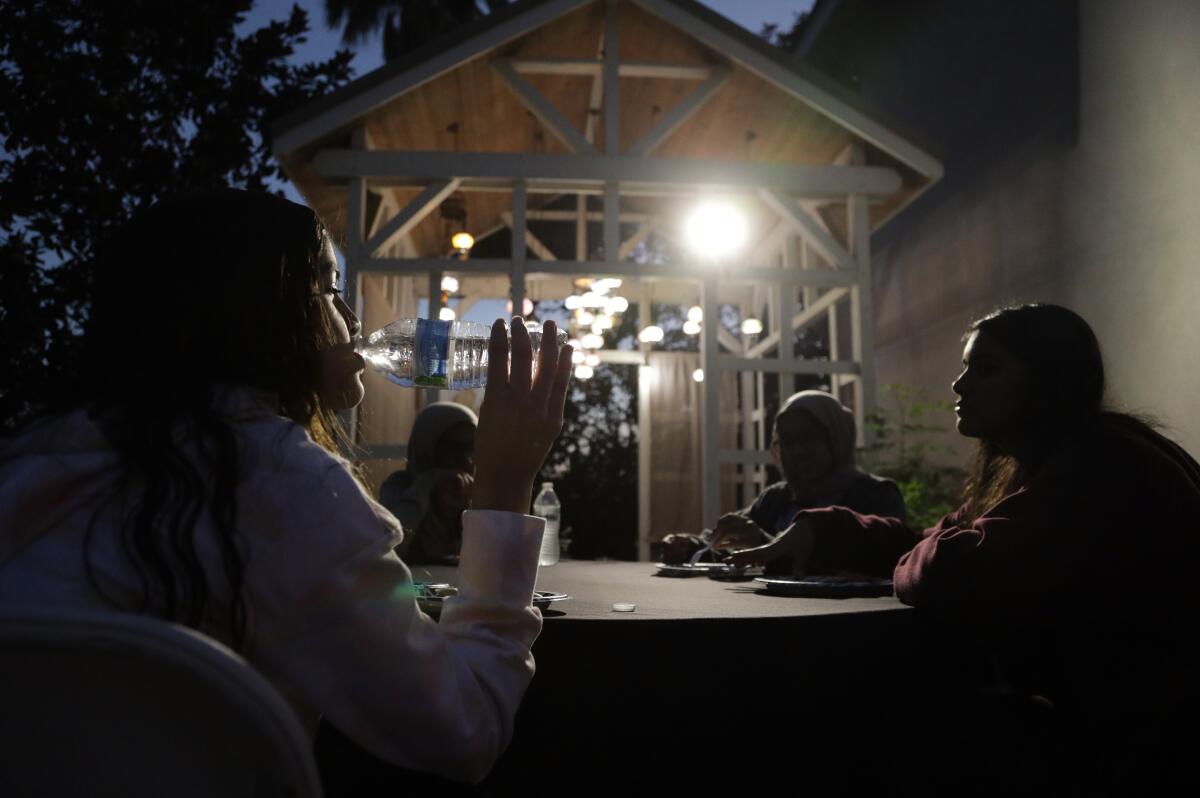Your Local SEO and Digital Marketing Experts in San Diego County
Muslim children typically aren’t expected to fast during Ramadan until they reach puberty. But often kids will want to start earlier because they see everyone else abstaining from food and water from sunrise to sunset — followed by their community gathering to break their fast together — and they want to participate.
“I really wanted to get in on the fun,” said Raahim Sattar, who started fasting when he was around 7. He’s an 18-year-old Danville native currently learning Arabic at the Qalam seminary in Dallas. He has older twin brothers — and a competitive streak: “I was like, hey, maybe I can do it better than them.”
Fatima Amawi, a 16-year-old Muslim Youth of North America volunteer from Orlando, Fla., remembers getting a special cake during the Eid celebration after completing her first full fast at age 9.
Years later, she still finds Ramadan fasting manageable. She drinks a cup of milk each day before the fast, because she grew up seeing her grandfather do that. She takes a break from her competitive horseback riding.
“In this day and age, there are a lot of things that can really take your mind off of hunger,” she said. “I just read a book or watch a TV show.”
In some ways, it’s easier for kids to fast because they haven’t built up as many bad habits, said Ussma Ghani, dietitian and holistic nutritionist at Nutriacs. They don’t have coffee addictions. They have endless amounts of energy. They’re also less bound to social norms, so if they are tired, they’ll just lie down anywhere and sleep.
But once kids get older, they often have to juggle their religious obligations with academics, extracurricular activities and other social pressures. In Muslim countries — or Islamic schools in the U.S. — entire schedules shift to accommodate Ramadan. But the holy month can be trickier to navigate in settings where peers and others may not understand Islam.
The Times talked to youths, parents, teachers and health experts to gather advice on how to support school-age children during Ramadan.
Sisters Asma Almutawa, 8, left, and Aceile Almutawa, 10, join friends as they break their fast with dates on April 6.
(Myung J. Chun/Los Angeles Times)
Fasting for the first time
“It’s honestly up to the kids and up to the family what they want to do,” said Aisha Aslam, the acting principal of Orange Crescent School, a private school founded by the Islamic Society of Orange County.
Kids can start by fasting for a few hours, by skipping lunch or by fasting only on the weekends. Aslam’s oldest daughter Aceile Almutawa, 10, started doing “baby fasts” three years ago and gradually eased into a full fast.
Salma Rashad, 19, a Cal Poly Pomona student, remembers crying as a kid when her parents told her she was too young to fast. “So when I started, my mom would say, ‘OK, you can fast until 11 a.m.’ At that age, it’s like a challenge. I really really wanted to make it until 1 p.m., then 3 p.m.”
Muslim dieticians contacted by The Times generally agreed that you want to be careful with kids who are fasting. “The last thing we want is for them to be losing weight when they should be growing,” said Sumiya Khan, a registered dietitian and co-founder of Sanctuary Kitchen.
But at the same time, kids are resilient and they can gain a lot from participating in spiritual traditions, said Shamila Malik, a registered dietitian at Fresenius Medical Care North America.
Much of the health advice for adults also applies to kids. Balanced and nutritious meals — with a focus on protein, fiber, complex carbs and healthy fats — will give them more sustained energy and avoid sugar crashes. Khan recommends supplementing their Ramadan diet with multivitamins, “just to give a little bit of insurance.” Hydration during the times they can have water is crucial.
Aslam was surprised how her kids took to fasting pretty easily and didn’t appear to be overly exhausted. But each child is different, she said, and it’s important not to compare.
“I think the struggle is more them just wanting things,” said Aslam. “It’s not so much that they need it, but, ‘I want this chocolate because I see it in the grocery store.’ Or they get too excited and want to play so much, and it’s like, ‘No, no, it’s 85 degrees outside, do something inside instead of going out and running around.’”

Kids run around Aisha Aslam’s yard, where friends and family have gathered for iftar on April 6.
(Myung J. Chun/Los Angeles Times)
Sattar, who plans to study law after he finishes his studies at the seminary, encourages young people, especially kids who aren’t yet required to fast, to not be too hard on themselves. He recalls a time when he was supposed to be fasting and absentmindedly popped some of his friend’s Goldfish crackers into his mouth, panicked and found the nearest trash can to spit it out.
“An accidental snack is a gift from God,” he said. “Just enjoy it, think of it as a booster and finish your fast strong.”
Don’t push kids beyond their capacity, Malik said. “You don’t want them to associate Ramadan with anxiety or stress,” she said. “Create memories, do arts and crafts, decorate the home, and include them in food prep.”
That will also help distract them from feeling hungry, Aslam said.
How to talk about fasting with your kids
Focus on the intention of Ramadan fasting. “Ramadan is meant to be a time of reflection, discipline and gratitude for our blessings,” Khan said. “And acknowledging that we are fortunate that we can break our fast with a beautiful meal with family and friends. Not everyone has that opportunity or privilege.”
While it’s important to monitor your kids, it’s also a good opportunity to teach them to pay attention to their bodies.
“Does their body need rest? Does their body need nutrition? It’s nice for kids to realize, ‘Right now, I’m hungry.’ ‘I think right now, I’m tired,’” she said. “So they know, ‘OK, let me sit down a little bit.’ ‘Let me drink some water.’”
Fatema Jivanjee-Shakir, a licensed clinical social worker who works at the Renfrew Center, recommends adults refrain from praising kids for not eating because it can lead to an unhealthy preoccupation with food.
Jivanjee-Shakir, who works with patients with eating disorders, also advises monitoring how young people — especially those going through puberty — are talking about their bodies and making sure that the practice of fasting is contained within the holy month.
Make sure kids understand that there are valid exemptions from fasting, including illness. Eating disorders are illnesses, Jivanjee-Shakir said.
“Islamic doctrine really encourages the protection of the body,” she said. “So if you’re protecting your body by not fasting because it harms your mental or physical health, then you are in fact honoring Islam and you are honoring the religion. It doesn’t make you a bad Muslim if you’re not able to fast.”

Aisha Aslam and her guests pray before their iftar meal on April 6.
(Myung J. Chun/Los Angeles Times)
Advice for kids navigating school
Ramadan was a big deal in Rashad’s house when she was a kid. She grew up in Chino Hills and attended Islamic private school. But when she started going to public school, she found that not a lot of kids knew about it.
So she’d invite her non-Muslim friends over to see the decorations — the lanterns and lights — and to break fast with her family. Her mom would jokingly compliment her on how she had “trained” all her friends to understand their culture.
Rashad, who started a Muslim youth mentorship program during the pandemic, said many of her mentees are nervous about fasting at school. She advises young people to find the other Muslims at their school, if possible. “That makes it a lot easier to fast when you have others there with you, to lift each other up,” she said.
But your supportive community is not limited to those who share your faith, she said. This is especially important for students who may not have that many Muslim classmates.
“A lot of youth, they tend to hear the horror stories, know the bullying and all the negative things that [happens to] our community,” she said. “But in reality, a lot of us at that age are very welcoming and accepting of all their friends.”
Abeer Shinnawi, a veteran middle school social studies teacher who is the program lead at Re-Imagining Migration, agreed and added that a trusted teacher can help too.
“If you’re too shy or don’t feel comfortable speaking, maybe have that teacher who can help you promote — if that’s what you want to do — or teach your peers,” Shinnawi said.
How parents and teachers can help
Help students create a schedule
It’s not just the fasting that makes Ramadan a challenge. Kids are also up before sunrise to eat. Then there are taraweeh prayers throughout the night — which are not required, but are an integral part of observing Ramadan in some families.
Rashad and Sattar said they ended up adjusting when they studied because it was hard to concentrate once they got more dehydrated in the afternoons.
Zakia Pathan, special education teacher at Discovery Charter School in San Jose, encourages teachers and parents to find ways to cut back on activities for their Muslim students during Ramadan if they can.
“It’s supposed to be a time where you’re simplifying your life,” she said. “Being calm, spending time with myself and reflecting on who I am — that’s a big component about Ramadan. And sometimes we don’t give our kids a chance to do that.”

Friends chat at the kids’ table during their iftar meal on April 6.
(Myung J. Chun/Los Angeles Times)
Ask teachers and coaches for accommodations
Here are some that can help students who are fasting:
- Options for P.E. and sports: Some students will have the stamina to participate while fasting, but others will need to take a break or do lighter versions of the activities. Watch for dehydration and exhaustion.
- Options for other places to go during lunch break: Some kids might want to sit with their friends, even if they’re not eating, because they think the time passes faster, said Sawsan Jaber, a high school English teacher at East Leyden High School in Illinois. Others may want to rest, nap, pray in private or work on homework in the library, a career center or a classroom.
- Flexibility with homework and exams: A lighter homework load or the ability to make up tests could be helpful. “It helps if teachers can be empathetic and understand sometimes the kids’ stamina might not be there or they might not be able to fully engage in the way they normally do,” Jaber said.
Why it’s important to be proactive, not just reactive
Amina Shahid, who teaches English at Miller Middle School in Cupertino, Calif., recently polled her Muslim students and found that a lot of the kids didn’t tell their non-Muslim teachers that they were observing Ramadan.
“They feel like their teachers don’t know what it is and then they feel awkward telling them they need accommodations,” she said. “Or they’ll feel nervous about having to make up tests or make up the mile run in P.E., so they’ll just do it even though they are fasting.”
Jaber said it’s important to recognize that many students — and possibly their parents too — will need help advocating for themselves.
“My parents are Palestinian refugees,” said Jaber, who also consults about how to create more equity for students of color through Education Unfiltered. “So their experience growing up was so different from mine that even if they wanted to be my advocate [at school] or if they wanted to be involved in my education, no one ever gave them those tools to be able to partake. So a lot of our children today may not have the support for a variety of different reasons.”
Use the month as an opportunity to teach
“There’s over 2 billion Muslims around the world who are celebrating and commemorating at this time,” said Maimona Afzal Berta, a school board member in the San Jose area who became the first hijabi Muslim elected to office in California in 2018.
One reason she ran for office is that her classroom — at a school in a diverse neighborhood — was vandalized with hate speech shortly after Donald Trump was elected president in 2016. That was a wake-up call.
“It’s important to have some level of understanding, just like you would want for Christmas or Easter,” she said.
Administrators can also send all-staff emails reminding their school community about Ramadan and offering ways they can help. Jaber penned an open letter to educators about Ramadan that’s been widely shared. Educators can also download a free poster about accommodating Muslim students during Ramadan, written by Aya Khalil and illustrated by Huda Fahmy.
Though some students, like Rashad, will jump at the chance to teach their peers about Ramadan, Jaber cautioned against putting Muslim students on the spot.
Talk to a student and their family privately first, Pathan said. You don’t want to make assumptions. But, “if the child is willing, or if the family is willing to share, that’s a great way to introduce it into your classroom,” she said.
Thomas Cendejas — who teaches religion at Loyola High School in Pico-Union — remembered a year when the students at his all-boys Roman Catholic school were excited to learn about food for Eid al-Fitr. At the end of Ramadan, a Muslim student’s parents brought in pastries for the entire classroom to share.
“They’re learning how to be sensitive to various traditions, and it’s nice when it comes up in natural and organic ways,” he said.
Rashad encourages her mentees to be open to answering questions. “I know a lot of other Muslims would say the opposite,” she said. “They’d say, ‘No, I’m fasting. I don’t want to deal with questions.’ But I honestly think answering those questions from the start clears up so many misconceptions, and it makes it easier in the long run.”
“Don’t be embarrassed,” she added. “Part of your identity is your religion. It’s something that you can own.”
About The Times Utility Journalism Team
This article is from The Times’ Utility Journalism Team. Our mission is to be essential to the lives of Southern Californians by publishing information that solves problems, answers questions and helps with decision making. We serve audiences in and around Los Angeles — including current Times subscribers and diverse communities that haven’t historically had their needs met by our coverage.
How can we be useful to you and your community? Email utility (at) latimes.com or one of our journalists: Jon Healey, Ada Tseng, Jessica Roy and Karen Garcia.










